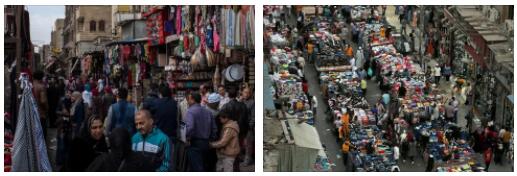Northeast African state. According to a 2005 estimate, the population of Egypt it amounted to 77,505,000 residents, almost double compared to 1970. The spread of birth control and urbanization have reduced the growth rate from 2.8 % per year in the 1980s to 1.78 % (2005). But for several years to come, the number of young people looking for their first job (estimated at 800,000 in 2005) will reflect the most sustained growth of previous years.
The vast majority of the Egyptian population is concentrated in the delta region and in the narrow valley of the Nile (overall 2.4 million ha, equal to about 5 % of the country’s total area). Overcrowding in the metropolitan area of the capital (Greater Cairo has more than 15 million residents) is such that the population has long since begun to flow back into areas outside the central part of the agglomeration, and into marginal areas occupied by the desert. In particular, starting from the 1980s, a system of new satellite or independent cities was created with the function of growth poles intended to decongest the central area; at first these cities were perceived by the residents of Cairo as if they were located at sidereal distances, but in the meantime they have become integral parts of the metropolis. It is expected that if urban growth continues along current trends, Greater Cairo will continue to expand rapidly along its major regional axes, particularly along the road linking Cairo to Alexandria. Along this Cairo, Il ).
The demographic growth and the scarcity of space suitable for settlements and crops have led the government to plan and implement, by 2015, an extension of useful land of the order of 800,000 km 2. In the long run, the goal is to colonize and populate 25 % of the nation’s total land area. In this expansion strategy outside the Nile Valley, the key projects are two large agro-industrial irrigation schemes: the al-Salām canal in the north-east and the Toshka canal in the deep south. The al-Salām canal, which will carry the water del Nile in the Sinai peninsula, is already at an advanced stage of construction: it is expected that in 2006 170 km2 ² will be taken from the desert. Half of the land will be used for agro-industrial crops, the other half for labor-intensive crops, such as floriculture. The Toshka project, hailed as an engineering feat comparable to the Aswan Dam, is under construction. The irrigation of the ‘New Valley’, which interconnects a series of oases in the Western Desert, has long been a national aspiration, repeatedly set aside as it was deemed too ambitious. In January 1997, President M.Ḥ. Mubārak inaugurated the twenty-year plan. In this period of time a branch channel from Lake Nasser, upstream of the dam, could reach the oasis of al-Farāfra, at 550 km away. In the first phase, the project should allow irrigation of 220 km 2 ². Furthermore, the desert area of al-̔Awaynāt, near the border with Sudan, is expected to be irrigated with water not derived from the Nile, but captured by deep underground aquifers. A ‘parallel Egypt’ is thus taking shape in the Western Desert, with two new cities and half a dozen areas with a high concentration of investments. The major unknown that weighs on these plans is whether there is an adequate availability of water resources, both in the Nile and in the desert subsoil.
Tourism, despite the repeated terrorist attacks that followed after the 1998 Luxor one (the most serious of which hit the tourist resort of Šarm al-Šayẖ on the Red Sea on 23 July 2005, causing about ninety victims, mostly Egyptians), it remains a key source of foreign currency, contributing between $ 3 and $ 4 billion annually. In addition to the income from tourism, Egypt it can count on three other important sources of foreign currency: oil exports, tolls for transit through the Suez Canal and remittances from emigrants.
According to Thedresswizard, oil exports, which make up almost half of the total value of exports, meet a limit in the relative scarcity of production (about 30,000 tons per year) and reserves, sufficient to cover just 11 years of production. In theory, oil could be replaced by natural gas, the reserves of which are much more consistent, were it not for the problems associated with the transportation of this energy source. In any case, any expansion of the capital-intensive hydrocarbon sector would not serve to reduce persistent underemployment.
The Suez Canal saw a significant decrease in oil traffic, which however, after 2003, was largely offset by the intensification of the traffic of ships, especially from the United States, bound for the Arabian Gulf area.
An important contribution to the state budget also derives from aid from abroad and from international financial institutions, for an amount of the order of 3 billion dollars. The strategic importance of Egypt it is such that strong countries, and in particular the United States, have traditionally been willing to provide their economic support.
The contribution of agriculture to the gross domestic product is gradually decreasing, but in 2005 the primary sector still contributed 15.5 % and employed 32 % of the active population. In the same year the manufacturing industries (textiles and clothing, chemical products, etc.) contributed 32.1 % to the formation of the GDP; the service sector for 52.4 %. The trade balance is largely in deficit. Among the main trading partners is Italy, which in 2004 absorbed 13.1 % of exports and supplied 17.1 % of imports.
